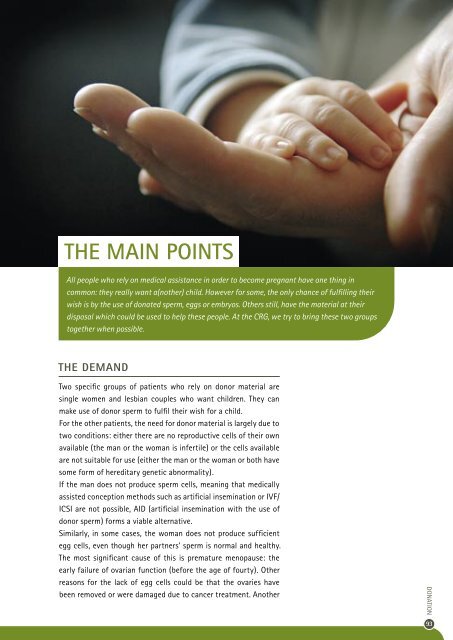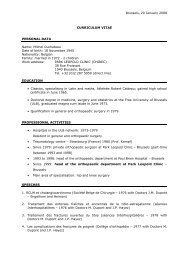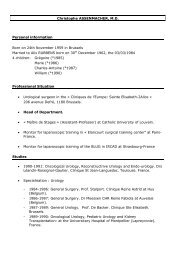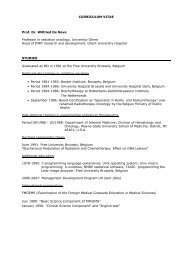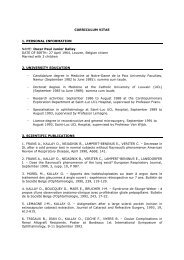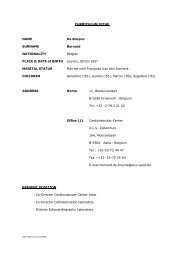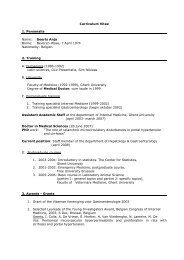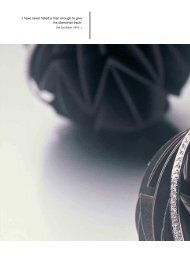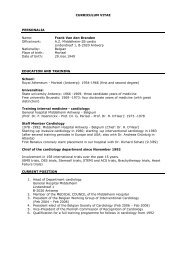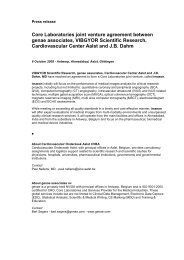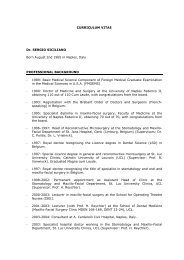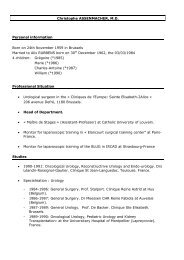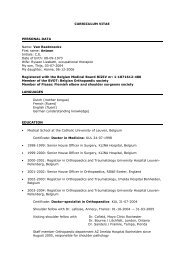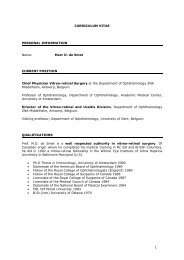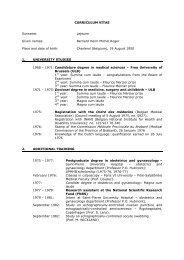Download PDF - HealthCare Belgium
Download PDF - HealthCare Belgium
Download PDF - HealthCare Belgium
You also want an ePaper? Increase the reach of your titles
YUMPU automatically turns print PDFs into web optimized ePapers that Google loves.
THE MAIN POINTS<br />
All people who rely on medical assistance in order to become pregnant have one thing in<br />
common: they really want a(nother) child. However for some, the only chance of fulfilling their<br />
wish is by the use of donated sperm, eggs or embryos. Others still, have the material at their<br />
disposal which could be used to help these people. At the CRG, we try to bring these two groups<br />
together when possible.<br />
THE DEMAND<br />
Two specific groups of patients who rely on donor material are<br />
single women and lesbian couples who want children. They can<br />
make use of donor sperm to fulfil their wish for a child.<br />
For the other patients, the need for donor material is largely due to<br />
two conditions: either there are no reproductive cells of their own<br />
available (the man or the woman is infertile) or the cells available<br />
are not suitable for use (either the man or the woman or both have<br />
some form of hereditary genetic abnormality).<br />
If the man does not produce sperm cells, meaning that medically<br />
assisted conception methods such as artificial insemination or IVF/<br />
ICSI are not possible, AID (artificial insemination with the use of<br />
donor sperm) forms a viable alternative.<br />
Similarly, in some cases, the woman does not produce sufficient<br />
egg cells, even though her partners’ sperm is normal and healthy.<br />
The most significant cause of this is premature menopause: the<br />
early failure of ovarian function (before the age of fourty). Other<br />
reasons for the lack of egg cells could be that the ovaries have<br />
been removed or were damaged due to cancer treatment. Another<br />
DONATION<br />
93
77<br />
DO YOU WISH TO BE A SPERM DONOR<br />
Contact us through<br />
www.spermadonor.be<br />
or call the Andrology Lab<br />
+32 2 477 66 52<br />
situation could be that the woman does produce egg cells, but<br />
that they are not suitable for use. Once a woman passes the age<br />
of 43, her own genetic material is no longer used for any form<br />
of medically assisted fertilization. The chance of the treatment<br />
being successful would then be too small (0.5%) to justify it. In<br />
all the above cases, egg donation may be considered as a possible<br />
solution.<br />
There are couples in which the fertility problem is a combination of<br />
factors affecting both the man and the woman. These people can<br />
possibly be helped by embryo donation.<br />
THE SUPPLY<br />
Concerning donor sperm demand and supply are more or less<br />
balanced, partly thanks to the fact that we can rely on foreign<br />
sperm banks like the Danish Cryos as well. Nevertheless our centre<br />
is continually looking for new donors. The greater and more varied<br />
the supply, the better the selection for the recipient couple.<br />
Furthermore, due to the growing number of patients that appeal<br />
to medically assisted fertilization the demand steadily grows,<br />
which increases the risk for a shortage. Our campaign ‘Become a<br />
Sperman!’ fits in with the efforts of the CRG to provide an answer<br />
to this issue. Visit www.spermadonor.be if you wish additional<br />
information.<br />
DONATION<br />
DO YOU WISH TO DONATE OVOCYTES<br />
OR EMBRYOS<br />
Contact us through<br />
www.eiceldonor.be<br />
Or call Consultation CRG on the main line<br />
+32 2 477 66 99<br />
The Consultation Department can also<br />
provide you all relevant information about<br />
obtaining donor material.<br />
78<br />
77| Image taken from the recruitment campaign for<br />
sperm donors ‘Become a Sperman!’<br />
78| Image taken from the recruitment campaign for<br />
egg donors ‘There is more in you!’<br />
As far as donor eggs and embryos are concerned however, there is<br />
a critical shortage. As a result of this, the CRG is actively seeking<br />
women and couples who are willing to help solve this problem. The<br />
campaign ‘There is more in you’ fits in with this search. Surf to<br />
www.eiceldonor.be if you want to learn more about this.<br />
Initially couples who undergo an IVF treatment themselves are drawn<br />
on for the recruitment of potential egg donors. For example, women<br />
who produce more ripe eggs than they need for their own treatment<br />
can donate some of them immediately after the egg pick-up. This<br />
principle is known as ‘egg sharing’ or ‘partial donation’. Couples who<br />
have a surplus of healthy embryos after successful treatment and<br />
have no need for them anymore (e.g. because their child wish is<br />
fulfilled) may also decide to donate them to (an)other couple(s).<br />
A specific demographic group amongst these potential donor<br />
patients are those who have need for donor material themselves,<br />
in this case donor sperm. Through a system of ‘solidarity donation’<br />
the CRG tries to motivate these women to act as egg donor, even<br />
partially.<br />
However, the CRG is also always actively looking for ‘voluntary’<br />
donors, i.e. women without any infertility problems of their own<br />
but who are willing to follow that part of the treatment required<br />
94
to allow the ‘harvesting’ of ripe eggs. In most cases, a volunteer is<br />
found by the couple who need treatment by egg donation, but the<br />
CRG also tries to encourage healthy young women from outside<br />
the IVF circuit to volunteer as egg donors.<br />
Anonymous or not<br />
A general rule is that the donors are not told who the recipients<br />
will be, and vice-versa. To be sure the new legislation (2007)<br />
concerning assisted fertilization and everything related leaves<br />
open the option for known donation, but nevertheless implies in<br />
the formulation of the rules altogether a marked preference for<br />
anonymity. A specific situation in which this general rule may be<br />
waived is that of egg donation, i.e. if the recipient couple explicitly<br />
chooses their own egg donor or the donor offers to help a specific<br />
couple. This is known as ‘named donation’.<br />
However, there are also cases where several couples each provide<br />
a donor and the donors are exchanged among the group. This<br />
‘exchange donation’ system allows couples to find donors among<br />
their own families or friends, while still safeguarding the principle<br />
of anonymity. See ‘Named donation versus exchange donation’<br />
p. 103 for the reason why this may be important.<br />
Strict selection and genetic screening<br />
Obviously, not everyone is a suitable donor. All donors need to<br />
undergo rigorous medical screening before they are approved as<br />
donors. For example, a detailed family history is mapped out and<br />
analysed thoroughly to identify recurring characteristics. General<br />
factors such as life expectancy, physical health, mental stability,<br />
etc. are important here.<br />
The preliminary testing procedures include determination of the<br />
donor’s blood group and rhesus factor and the blood is also tested<br />
for the presence of infections such as hepatitis (jaundice) and HIV<br />
(the AIDS virus).<br />
A phenotype profile is compiled of every sperm donor. This involves<br />
the donor’s characteristics, i.e. hair and eye colour, skin colour,<br />
build, etc. When donor sperm is used, great care is always taken<br />
to ensure that the donor’s blood group and as many physical<br />
characteristics as possible match those of the recipient couple.<br />
79| Genetic map (karyotype) of a woman.<br />
80| Genetic map of a man.<br />
79<br />
80<br />
Unfortunately, this strict phenotype selection is not possible in<br />
cases of egg and embryo donation because the supply of donors is<br />
too limited and the treatment too complex. Furthermore, volunteer<br />
egg and embryo donors can only be recruited from among women<br />
up to the age of 35 years. Exceptions to this rule are only made in<br />
certain cases of named donation and with the recipient couple’s<br />
explicit permission.<br />
DONATION<br />
95
Double screening after six months<br />
All donated sperm, eggs and embryos are subjected to extensive<br />
medical screening too. Naturally, this includes genetic screening<br />
to avoid congenital disorders. Frozen sperm is always stored for at<br />
least six months before use. This precaution is taken because some<br />
infections, especially HIV, can only be detected during this period.<br />
Repeating the screening processes after this period and before the<br />
sperm is used allows the CRG to guarantee that the donor sperm<br />
is healthy.<br />
This double screening (double checking) cannot be applied to eggs,<br />
however. Egg donation always requires fresh material because<br />
eggs cannot be frozen and stored. All egg donors undergo the<br />
same thorough medical and genetic screening processes as those<br />
applied to donors of semen or embryos, but the eggs cannot be held<br />
in quarantine for several months. This means that no conclusive<br />
guarantee of infection-free status can be given for donor eggs.<br />
Nevertheless, the CRG’s careful screening and precautions<br />
are sufficiently rigorous to reduce the chances of infection to<br />
practically zero.<br />
WHO ARE THE LEGAL<br />
MOTHER AND FATHER<br />
DONATION<br />
In <strong>Belgium</strong>, the law makes no distinction between couples who<br />
conceive naturally and couples who use donor sperm, eggs or<br />
embryos. The woman who gives birth to the child is always the legal<br />
mother. If the woman is married, her husband is automatically the<br />
legal father. If the woman is unmarried, her partner may voluntarily<br />
acknowledge the child and thus become the legal father.<br />
That is why your embryos, sperm or eggs cannot be used to help<br />
other couples without your written consent. You will have to<br />
complete and sign a form before any treatment can begin. By doing<br />
so, you relinquish your sperm and eggs, they are no longer yours.<br />
The woman or couple accepting the donor material as well are<br />
required to sign a form confirming that they accept it.<br />
96
SPERM DONATION<br />
As mentioned above, supply and demand are more or less in<br />
balance with regards to sperm donation, although this is can’t be<br />
taken for granted anymore since demand is steadily rising. Anyway,<br />
the major advantage of sperm is that it can be produced easily and<br />
frequently, then frozen and stored.<br />
The most important prerequisite for sperm donors is that they<br />
are aged between 18 and 44, and healthy. In order to verify the<br />
latter a number of tests are conducted prior to the donation. But<br />
apart from that donors do not require any medical treatment. They<br />
are merely asked to refrain from ejaculating for a number of days<br />
running up to the donation and to travel to the location where<br />
they will produce or deliver the sperm sample.<br />
For example volunteers are recruited amongst the student<br />
population of the Vrije Universiteit Brussel (VUB), the staff of the<br />
Universitair Ziekenhuis (UZ Brussel), among men due to have a<br />
vasectomy or men who are to undergo a fertility treatment with<br />
their partner and whose sperm has been deemed fit.<br />
But of course also other men are welcome!<br />
DONATION<br />
97
Although in principle there is no limit to the number of times a<br />
donor may donate, practice tells us differently. When the donor’s<br />
sperm has resulted in the successful birth of a certain number of<br />
children sperm donation has to be discontinued to avoid the risk<br />
for consanguinity, i.e. the risk that children from the same parents<br />
have children together.<br />
81<br />
All in all these factors allow a sperm bank to be built up for use<br />
at the right time during treatment and ensure the availability<br />
of sperm from a wide range of different donors. Be advised this<br />
doesn’t mean that as a patient you can reserve donor sperm for<br />
multiple inseminations (yet).<br />
82<br />
Donor sperm may offer a solution for couples where the woman’s<br />
fertility is normal but the man produces no or too few (motile)<br />
sperm for use in the treatment. Couples in which both partners<br />
are carriers of the same genetic defects may also be able to reduce<br />
the risk of transmitting the genetic abnormality to the child they<br />
conceive by using donor sperm .<br />
81| Donor sperm bank.<br />
82| Healthy sperm.<br />
ARTIFICIAL INSEMINATION<br />
Details of what the treatment involves are given in the ‘Artificial<br />
insemination’ section of this guide (p. 53).<br />
DO YOU WANT TO BECOME A SPERM DONOR<br />
Please surf to www.spermadonor.be or call the Laboratory<br />
of Andrology: +32 2 477 66 52.<br />
For more information about receiving donor materiaal, please<br />
contact Consultation CRG on the main line:<br />
+32 2 477 66 99<br />
DONATION<br />
98
EGG DONATION<br />
Egg donation offers the only chance of conception for a woman<br />
who produces too few or no eggs, or eggs that are unsuitable for<br />
genetic reasons. Sperm supplied by her partner (the ‘recipient man’)<br />
are injected directly into the eggs donated by another woman to<br />
inseminate them (a technique known as ICSI).<br />
If this in vitro fertilization produces a number of embryos, one<br />
or two will be transferred to the woman’s womb, where they can<br />
implant and grow to full term.<br />
The CRG has four egg donation formulas: partial donation (known<br />
as ‘egg sharing’), named donation and exchange donation. Those<br />
last two formulas apply to couples who can present a donor<br />
themselves; the first one to couples who don’t/can’t do that. The<br />
latter automatically land in the waiting list donation system as<br />
candidate acceptor, where they – apart from egg sharing – can<br />
appeal on voluntary anonymous donation (which is the fourth<br />
formula).<br />
RECRUITMENT<br />
We have reviewed the general conditions to which donors must<br />
conform previously (see p. 95-96). One of these is that the<br />
maximum age for egg donors is 35. Exceptions to this rule are only<br />
made in certain cases of named donation and with the recipient<br />
DONATION<br />
99
83| Through the awareness campaign ‘There is more<br />
in you’ the CRG aims at making the egg cell<br />
donation issue known to a wider audience.<br />
83<br />
couple’s explicit permission. If egg donation and IVF treatment<br />
result in a pregnancy, the recipient couple are advised to have a<br />
prenatal diagnosis (see ‘More than medical’, p. 84 and further)<br />
Another general principle is that donation is preferably anonymous.<br />
This is one of the reasons why the CRG has organised the ‘exchange<br />
donation’ system for couples who introduce their own donor to<br />
our Centre, since it allows an anonymous alternative to ‘named<br />
donation’ (see further on). Nevertheless, if the couple and the<br />
donor in question explicitly request that the donated eggs be used<br />
for the couple’s treatment, we will always give this request serious<br />
consideration.<br />
Whatever may be the recruitment of egg cell donors is a lot less<br />
obvious than that of sperm donors. The treatment is rather time<br />
consuming, physically slightly uncomfortable and not entirely riskfree.<br />
In other words, egg donation requires substantial motivation<br />
and commitment on the part of the donor.<br />
As a result the number of voluntary anonymous donors – those<br />
who undergo the treatment solely to donate their eggs to a couple<br />
unknown to them– is rather limited. This is one of the reasons why<br />
the CRG prefers to recruit women who already have children or are<br />
having treatment. They are not only ideally placed to understand<br />
the longing for a child, their body also has ‘experience’ with the<br />
physical effects of hormonal changes.<br />
MOTIVATION AND RISKS<br />
DONATION<br />
What exactly is expected of an egg donor<br />
First of all, she needs to be able to make time available for the<br />
various examinations and visits to the hospital. The necessary and<br />
frequent blood samples and ultrasound scans mean she will have<br />
to remain available constantly over the course of treatment.<br />
She must also be prepared to follow the hormone treatment which<br />
suppresses the normal menstrual cycle and stimulates her ovaries<br />
to produce several ripe eggs. Over the course of this stimulation<br />
process, she may have a painful or hypersensitive abdomen.<br />
Cysts may also form in some cases, although this is a harmless<br />
phenomenon. Cysts only need to be removed in a small medical<br />
procedure guided by ultrasound scan (see ‘Medical practice’, p. 60)<br />
if they start producing hormones themselves.<br />
However any egg cell donation requires a churgical procedure to<br />
collect the eggs. This is only a minor procedure, almost always<br />
carried out under local anaesthetic, but it is an operation. Although<br />
all necessary medical precautions are taken, the chance of an<br />
infection cannot be entirely excluded. Any such infection carries a<br />
risk of infertility for the donor, which is all the more delicate in view<br />
of the fact that young women are preferred for egg donation.<br />
100
Finally, and strange as this may seem, the greatest ‘risk’ that an<br />
egg donor runs is of becoming pregnant herself during treatment!<br />
If she had no plans in this sense, this can be a severe problem.<br />
Egg donors are therefore expected to refrain from unprotected<br />
sexual relations for a significant period of time. Total abstention<br />
from all sexual activity at the end of the stimulation cycle is<br />
necessary. She must also avoid intercourse for several days after<br />
egg collection (pick-up) unless protected by a condom to avoid<br />
fertilization of any remaining ripe eggs.<br />
THE TREATMENT<br />
Timing and synchronisation<br />
The fact that eggs cannot yet be frozen and stored presents a<br />
further complication for egg donors. This means that fresh eggs<br />
are always required, and the donor’s and the recipient’s treatments<br />
need to be perfectly synchronised.<br />
The donor follows the IVF treatment course through to egg pickup:<br />
medical screening and analyses, ovarian stimulation via<br />
hormone injections, intermediate blood tests, ultrasound scans<br />
and, finally, an hCG injection to conclude the egg ripening process.<br />
For precise details, we refer to the ‘Medical practice’ section, p. 31<br />
and further on.<br />
Naturally, the egg recipient follows the same procedures as for<br />
embryo transfer in the full IVF treatment. Her womb is prepared to<br />
receive the embryo after (medically) fooling the normal menstrual<br />
cycle into an artificially-induced cycle.<br />
Because of all these factors, the<br />
CRG pays great attention to medical<br />
counselling of egg donors. As a result<br />
of the severe shortage of donor eggs,<br />
we apply our greatest professional<br />
skills because we expect a high degree<br />
of commitment and motivation from<br />
egg donors. Every measure is taken<br />
to reduce the risk of infection to the<br />
smallest possible degree.<br />
Why an artificial cycle<br />
Egg cells must be fertilized as quickly as possible after collection, with the recipient man’s sperm. Then ideally,<br />
one or two of the resulting embryos are placed in the recipient woman’s uterus three days or five days after<br />
conception. The artificial cycle means that the uterus can easily be kept in an optimal condition for the arrival<br />
of the embryos for a number of days. The hormones used to do this have no negative effects, even with<br />
prolonged use.<br />
In practice, the recipient’s cycle is always synchronised to the<br />
donor’s cycle. If the donor is ready for egg pick-up, the recipient’s<br />
womb must be prepared for embryo transfer. Naturally, a delay of<br />
three or five days is also required between pick-up and transfer to<br />
allow for insemination and development of the fertilized eggs into<br />
embryos.<br />
Insemination: preferably by ICSI<br />
The recipient man is expected to supply a fresh sperm sample on<br />
the day the eggs are collected from the egg donor; this sperm is<br />
used immediately to inseminate the eggs.<br />
DONATION<br />
101
84<br />
Frozen sperm may be used if the man is unable to supply fresh<br />
sperm on the day of pick-up (e.g. because he lives or has to travel<br />
abroad). The frozen sample is then thawed a few hours before<br />
insemination. However, fresh sperm is always preferred, especially<br />
when used with donated eggs, because the chances of a successful<br />
IVF outcome increase significantly.<br />
For the same reason insemination of donated eggs with sperm from<br />
the recipient woman’s partner is best done using ICSI (i.e. direct<br />
injection of one sperm into each egg). This insemination technique<br />
has a ninety percent success rate (in terms of fertilization), which<br />
is essential to have a reasonable chance of pregnancy. After all,<br />
in the case of egg donation, fewer eggs are available for each<br />
fertilization attempt.<br />
<br />
<br />
<br />
<br />
<br />
<br />
<br />
<br />
<br />
<br />
<br />
<br />
84| ICSI.<br />
85| Lab set up for ICSI.<br />
86| Consent form for egg sharing.<br />
85<br />
<br />
<br />
<br />
<br />
<br />
<br />
<br />
<br />
<br />
<br />
<br />
<br />
<br />
<br />
<br />
<br />
<br />
<br />
<br />
<br />
<br />
<br />
<br />
<br />
86<br />
PARTIAL DONATION<br />
A logical form of donation is partial donation (egg sharing), whereby<br />
the donor is a woman who is already having IVF treatment herself.<br />
Naturally, this applies to women who are able to produce their own<br />
fertile eggs, that will be fertilized with their partner’s sperm.<br />
One treatment, two chances<br />
Egg sharing cancels out all the objections already discussed<br />
under ‘Motivation and Risks’. The woman is already having the IVF<br />
treatment and is well aware of the potential risks and physical<br />
discomfort. The fact that she is an egg donor at the same time<br />
involves no extra burden or treatment.<br />
It is therefore standard procedure at the CRG to ask this woman,<br />
or more correctly this couple, if she or they might be willing to<br />
donate any surplus eggs. Motivation is rarely a problem because<br />
two people who use assisted fertilization techniques to achieve<br />
their dream of a child understand another couple’s problems of<br />
infertility more readily.<br />
However, it is not a foregone conclusion that every ovarian<br />
stimulation cycle will lead to the production of sufficient quantities<br />
of eggs to allow donation. Thus, while a recipient may be ready<br />
for embryo transfer, the procedure may need to be postponed<br />
if the donor has not produced sufficient eggs to allow in vitro<br />
fertilization and transfer to the other woman’s womb.<br />
DONATION<br />
Counting the eggs<br />
A certain number of eggs need to be fertilized to have a real chance<br />
of embryo development. Egg sharing donations can proceed only<br />
if ovarian stimulation has allowed the collection of at least eight<br />
ripe eggs. Half of those are reserved for the donor’s own use, the<br />
rest is donated.<br />
102
In case of an uneven number of eggs, the extra egg<br />
goes to the donor. If ovarian stimulation only yields<br />
seven or less eggs, the egg-sharing is terminated.<br />
Surplus embryos<br />
If the in vitro fertilization produces more than the<br />
required number of embryos needed for transfer to<br />
the recipient woman’s womb, the surplus embryos<br />
are frozen and stored for transfer at a later date.<br />
Mevr. L. Van Waesberghe<br />
Laarbeeklaan 101<br />
B-1090 Brussel<br />
Anonymous<br />
tel.: +32 2 477 88 88<br />
fax: +32 2 477 88 89<br />
Egg sharing donations are always anonymous, as are<br />
sperm and embryo donation. The couple who donate<br />
the eggs are not told who is to receive them, and<br />
the recipient couple are not told the identity of the<br />
donor couple. Eligible couples are those who can’t<br />
provide their own donor and thus were put on the waiting list<br />
(cfr. p. 106).<br />
NAMED DONATION VERSUS<br />
EXCHANGE DONATION<br />
Centrum<br />
Reproductieve Geneeskunde<br />
If a couple supplies its own egg donor this does not necessarily<br />
imply named donation. Exchange donation is also an option.<br />
Named donation<br />
Pressure can be considerable to opt for named donation when a<br />
couple provides its own donor. This means the couple in question<br />
will be treated exclusively with eggs collected from their donor.<br />
For the donor it can often be an ‘exclusive’ motivation to give her<br />
eggs to that specific couple. Very often, the donor is the woman’s<br />
sister or her brother’s wife. Family loyalty can also influence the<br />
recipient couple in their decisions. They have asked someone they<br />
trust to be a donor, to whom they may be related, who may even<br />
look like them and with whom they may share a common genetic<br />
history.<br />
Sometimes named donation is the only possible solution, for<br />
example when the donor the couple provide is over 35 years old,<br />
and therefore cannot be considered for inclusion in the regular<br />
donor network. Skin colour may also limit the available options.<br />
Exchange donation<br />
This donation procedure involves exchanging the donors supplied<br />
by several couples among the group. Using a well-defined, tried<br />
and tested allocation system, especially designed to exclude the<br />
possibility of a couple receiving eggs from their own donor, each<br />
04/2007/DRUK<br />
Geachte mevrouw,<br />
U staat geregistreerd als kandidaat acceptor<br />
van eicellen en/of embryo’s in het CRG van<br />
UZ Brussel.<br />
Als u in de toekomst verder in aanmerking<br />
wil komen als acceptor, gelieve dan bij elke<br />
nieuwe menstruele cyclus waarin u een eicel<br />
of embryo zou willen ontvangen, bijgevoegd<br />
kaartje in te vullen en op te sturen.<br />
Het ingevulde kaartje moet ons in staat stellen<br />
om u op het juiste moment van uw cyclus<br />
te contacteren ingeval wij over biologisch ma-<br />
teriaal zouden beschikken.<br />
Graag terugzenden of -faxen naar:<br />
UZ Brussel<br />
CRG - Monitoring<br />
Laarbeeklaan 101 – 1090 Brussel Tel. +32 (0)2 477 66 99 – Fax +32 (0)2 477 66 49 www.brusselsivf.be<br />
Chère madame,<br />
Vous êtes sur la liste des candidates receveuses<br />
d’embryons et/ou d’ovocytes du CRG de<br />
l’UZ Brussel.<br />
Pourriez-vous remplir la fiche ci-jointe chaque<br />
fois que vous commencerez un cycle menstruel<br />
pendant lequel vous voudriez accepter<br />
un embryon ou ovocyte disponible.<br />
Veuillez bien nous envoyer cette fiche à<br />
l’adresse mentionnée ci-dessous.<br />
Cette fiche nous permettra de vous contacter<br />
au cas où nous aurions du matériel biologique<br />
disponible à un moment propice de votre<br />
cycle.<br />
ACCEPTOR<br />
RECEVEUSE<br />
Meisjesnaam / Nom de jeune fille /<br />
Dear Madam,<br />
Veuillez retourner à:<br />
Please return to:<br />
Voornaam / Prénom /<br />
UZ Brussel<br />
UZ Brussel<br />
First name k. . . . . . . . . . . . . . . . . . . . . . . . . . . . . . . . . . . . . . . . . . . . . . . . . . . . . . . . . .<br />
CRG - Monitorage<br />
CRG - Monitoring<br />
You are enrolled on the waiting list for accepting<br />
oocytes and/or embryos of the CRG of<br />
UZ Brussel.<br />
May we kindly ask you to send to us the enclosed<br />
document – filled out – each time you<br />
start a menstrual cycle during which you are<br />
prepared to accept available oocytes and/or<br />
embryos. Please return this document to the<br />
address mentioned below.<br />
Maiden name k . . . . . . . . . . . . . . . . . . . . . . . . . . . . . . . . . . . . . . . . . . . . . . . . . . . . .<br />
This document will enable us to contact you in<br />
case of availabilities according to your cycle.<br />
Mevr. L. Van Waesberghe<br />
Mevr. L. Van Waesberghe<br />
Laarbeeklaan Geboortedatum 101 / Date de naissance /<br />
Laarbeeklaan 101<br />
B-1090 Birthday Brussel k . . . . . . . . . . . . . . . . . . . . . . . . . . . . . . . . . . . . . . . . . . . . . . . B-1090 . . . . . . . . . . . Brussel . .<br />
tel.: Eerste +32 2 dag 477 van 88 88 de cyclus / Premier jour des règles tel.: /<br />
+32 2 477 88 88<br />
fax: +32 2 477 88 89<br />
fax: +32 2 477 88 89<br />
First day of cycle k . . . . . . . . . . . . . . . . . . . . . . . . . . . . . . . . . . . . . . . . . . . . . . . . .<br />
Meisjesnaam / Nom de jeune fille /<br />
Maiden name k . . . . . . . . . . . . . . . . . . . . . . . . . . . . . . . . . . . . . . . . . . . . . . . . . . . . .<br />
Voornaam / Prénom /<br />
First name k. . . . . . . . . . . . . . . . . . . . . . . . . . . . . . . . . . . . . . . . . . . . . . . . . . . . . . . . . .<br />
Geboortedatum / Date de naissance /<br />
Birthday k . . . . . . . . . . . . . . . . . . . . . . . . . . . . . . . . . . . . . . . . . . . . . . . . . . . . . . . . . . . .<br />
Eerste dag van de cyclus / Premier jour des règles /<br />
First day of cycle k . . . . . . . . . . . . . . . . . . . . . . . . . . . . . . . . . . . . . . . . . . . . . . . . .<br />
Meisjesnaam / Nom de jeune fille /<br />
Maiden name k . . . . . . . . . . . . . . . . . . . . . . . . . . . . . . . . . . . . . . . . . . . . . . . . . . . . .<br />
Voornaam / Prénom /<br />
First name k. . . . . . . . . . . . . . . . . . . . . . . . . . . . . . . . . . . . . . . . . . . . . . . . . . . . . . . . . .<br />
Geboortedatum / Date de naissance /<br />
Birthday k . . . . . . . . . . . . . . . . . . . . . . . . . . . . . . . . . . . . . . . . . . . . . . . . . . . . . . . . . . . .<br />
Eerste dag van de cyclus / Premier jour des règles /<br />
First day of cycle k . . . . . . . . . . . . . . . . . . . . . . . . . . . . . . . . . . . . . . . . . . . . . . . . .<br />
Meisjesnaam / Nom de jeune fille /<br />
Maiden name k . . . . . . . . . . . . . . . . . . . . . . . . . . . . . . . . . . . . . . . . . . . . . . . . . . . . .<br />
Voornaam / Prénom /<br />
First name k. . . . . . . . . . . . . . . . . . . . . . . . . . . . . . . . . . . . . . . . . . . . . . . . . . . . . . . . . .<br />
Geboortedatum / Date de naissance /<br />
Birthday k . . . . . . . . . . . . . . . . . . . . . . . . . . . . . . . . . . . . . . . . . . . . . . . . . . . . . . . . . . . .<br />
Eerste dag van de cyclus / Premier jour des règles /<br />
First day of cycle k . . . . . . . . . . . . . . . . . . . . . . . . . . . . . . . . . . . . . . . . . . . . . . . . .<br />
fax +32 2 477 88 89<br />
fax +32 2 477 88 89<br />
fax +32 2 477 88 89<br />
fax +32 2 477 88 89<br />
INS-ACCEPT<br />
Meisjesnaam / Nom de jeune fille /<br />
Maiden name k . . . . . . . . . . . . . . . . . . . . . . . . . . . . . . . . . . . . . . . . . . . . . . . . . . . . .<br />
Voornaam / Prénom /<br />
First name k. . . . . . . . . . . . . . . . . . . . . . . . . . . . . . . . . . . . . . . . . . . . . . . . . . . . . . . . . .<br />
Geboortedatum / Date de naissance /<br />
Birthday k . . . . . . . . . . . . . . . . . . . . . . . . . . . . . . . . . . . . . . . . . . . . . . . . . . . . . . . . . . . .<br />
Eerste dag van de cyclus / Premier jour des règles /<br />
First day of cycle k . . . . . . . . . . . . . . . . . . . . . . . . . . . . . . . . . . . . . . . . . . . . . . . . .<br />
Meisjesnaam / Nom de jeune fille /<br />
Maiden name k . . . . . . . . . . . . . . . . . . . . . . . . . . . . . . . . . . . . . . . . . . . . . . . . . . . . .<br />
Voornaam / Prénom /<br />
First name k. . . . . . . . . . . . . . . . . . . . . . . . . . . . . . . . . . . . . . . . . . . . . . . . . . . . . . . . . .<br />
Geboortedatum / Date de naissance /<br />
Birthday k . . . . . . . . . . . . . . . . . . . . . . . . . . . . . . . . . . . . . . . . . . . . . . . . . . . . . . . . . . . .<br />
Eerste dag van de cyclus / Premier jour des règles /<br />
First day of cycle k . . . . . . . . . . . . . . . . . . . . . . . . . . . . . . . . . . . . . . . . . . . . . . . . .<br />
Meisjesnaam / Nom de jeune fille /<br />
Maiden name k . . . . . . . . . . . . . . . . . . . . . . . . . . . . . . . . . . . . . . . . . . . . . . . . . . . . .<br />
Voornaam / Prénom /<br />
First name k. . . . . . . . . . . . . . . . . . . . . . . . . . . . . . . . . . . . . . . . . . . . . . . . . . . . . . . . . .<br />
Geboortedatum / Date de naissance /<br />
Birthday k . . . . . . . . . . . . . . . . . . . . . . . . . . . . . . . . . . . . . . . . . . . . . . . . . . . . . . . . . . . .<br />
Eerste dag van de cyclus / Premier jour des règles /<br />
First day of cycle k . . . . . . . . . . . . . . . . . . . . . . . . . . . . . . . . . . . . . . . . . . . . . . . . .<br />
Meisjesnaam / Nom de jeune fille /<br />
Maiden name k . . . . . . . . . . . . . . . . . . . . . . . . . . . . . . . . . . . . . . . . . . . . . . . . . . . . .<br />
Voornaam / Prénom /<br />
First name k. . . . . . . . . . . . . . . . . . . . . . . . . . . . . . . . . . . . . . . . . . . . . . . . . . . . . . . . . .<br />
Geboortedatum / Date de naissance /<br />
Birthday k . . . . . . . . . . . . . . . . . . . . . . . . . . . . . . . . . . . . . . . . . . . . . . . . . . . . . . . . . . . .<br />
Eerste dag van de cyclus / Premier jour des règles /<br />
First day of cycle k . . . . . . . . . . . . . . . . . . . . . . . . . . . . . . . . . . . . . . . . . . . . . . . . .<br />
87<br />
87| The form with which a waiting list acceptor<br />
states every month that she is still a candidate for<br />
egg cell donation.<br />
fax +32 2 477 88 89<br />
fax +32 2 477 88 89<br />
fax +32 2 477 88 89<br />
fax +32 2 477 88 89<br />
The major advantage of exchange<br />
donation, medically speaking, is the<br />
two attempts with freshly donated<br />
eggs. This system gives each recipient<br />
couple two chances in each treatment<br />
cycle, thus proportionally increasing<br />
the chances of success.<br />
As mentioned above, any surplus<br />
named donation embryos can be frozen<br />
and stored for later use, but our<br />
experience of assisted fertilization<br />
shows that the chances of success are<br />
undisputedly higher using fresh donor<br />
embryos for transfer.<br />
DONATION<br />
103
donor’s eggs are used in the treatment of two recipient women,<br />
also known as acceptors. Thus each acceptor is entitled to two<br />
donations.<br />
However, if ovarian stimulation fails to produce sufficient eggs for<br />
donation to two recipients (the number of eggs is less than or<br />
equals five), they can still be used for one recipient. In this case<br />
the acceptor who has presented the donor of five egg cells or less<br />
only is entitled to one donation.<br />
As soon as a recipient is pregnant, she drops out of the allocation<br />
system and her place is taken by a new recipient. If however there<br />
is no resulting pregnancy, she is entitled to a second attempt, with<br />
(logically) other material. Just to be perfectly clear: if the acceptor<br />
becomes pregnant at the first attempt she has no right to a second<br />
donation, unless the pregnancy results in a miscarriage.<br />
Benefits and drawbacks<br />
It is not always easy for a couple with a donor to weigh the two<br />
donation options. What are the benefits and drawbacks<br />
In terms of treatment<br />
From a purely medical viewpoint, named donation may be seen as<br />
a benefit or a drawback.<br />
For the recipient couple<br />
In principle, a couple that supplies its own donor will automatically<br />
have exclusive use of all the eggs produced by their donor. If the<br />
donor produces a large number of eggs, this is a definite benefit. All<br />
the eggs are fertilized using the recipient man’s sperm and, if this<br />
produces more embryos than needed for transfer to the woman’s<br />
uterus, the surplus embryos will be frozen and stored. These can<br />
later be used if the first treatment fails to produce a pregnancy or<br />
if the couple wants another child at a later date.<br />
However, if the donor produces only a few eggs after ovarian<br />
stimulation, the benefit turns into a drawback. The smaller the<br />
number of ripe eggs available for fertilization, the smaller the chance<br />
of the treatment producing surplus embryos. If embryo transfer<br />
using all the available embryos fails to produce a pregnancy for<br />
the recipient woman, she will have to repeat the entire treatment<br />
cycle, either using the same donor (if she is willing) or with a new<br />
donor.<br />
DONATION<br />
For the donor<br />
The fact that the same batch of donated eggs can be used to<br />
help two women can be a strong motivation for the donor. She<br />
undergoes ovarian stimulation treatment with a positive mindset:<br />
the desire to donate her eggs to benefit other women. This positive<br />
104
contribution can have an amplified effect in the exchange donation<br />
system, not only because the donation helps two recipients, but<br />
also because it increases the chances of pregnancy for the woman<br />
whom the donor originally set out to help.<br />
In terms of waiting list<br />
One undisputed advantage of named donation is that there is no<br />
waiting list. Once the couple has found a donor who meets all<br />
medical requirements, the treatment can begin. Synchronising the<br />
donor’s and the recipient’s treatment is more easily arranged too<br />
because direct arrangements can be made.<br />
There is indeed a waiting list for exchange donation, which varies<br />
according to the supply. On the other hand, the benefit of waiting<br />
should not be neglected. Because exchange donation entitles the<br />
woman to two attempts using freshly donated eggs, her chances<br />
of pregnancy at the end of the treatment are higher than through<br />
named donation.<br />
In terms of anonymity<br />
Then there is the argument of anonymity. By definition, named<br />
donation cannot be anonymous, whereas exchange donation is.<br />
As stated previously, the CRG strongly recommends the second<br />
option for a number of psychological reasons.<br />
Anonymity is a good way to safeguard both the donor and the<br />
recipient from disappointment, arguments and conflicts of interest.<br />
No matter how good their relationship today may be, there is no<br />
way of predicting what might happen in five or ten years’ time. This<br />
is especially the case if something goes wrong with the pregnancy<br />
or the child has a congenital disorder. Under these circumstances<br />
chances are that the relationship between the donor and recipient<br />
couple become very strained because of the feelings of guilt.<br />
However, conflicts cannot be excluded even if everything goes well.<br />
Differences of opinion may arise over how open the parents should<br />
be with the child regarding his or her origins. The recipient couple<br />
may expect the donor to remain emotionally involved with the<br />
child, whereas this may not be what the donor has in mind at all.<br />
Or the donor may want to remain emotionally involved throughout<br />
the pregnancy and birth, whilst the recipient couple have difficulty<br />
with this.<br />
All these potential psychological<br />
complications can be avoided by<br />
keeping the donation anonymous.<br />
Anonymous donation draws a clear<br />
line between the lives (and perhaps<br />
the family) of the donor and the<br />
recipients, and everyone’s attitudes<br />
are clear right from the start.<br />
DONATION<br />
105
WAITING LIST DONATION<br />
Precious<br />
harvest<br />
Egg cell Donation<br />
Awareness Campaign<br />
By this donation formula we mean that the recipient couple<br />
does not provide a donor, perhaps because they do not want to<br />
involve anyone they know in their treatment. They need to wait<br />
for an anonymous donor who either follows the fertility treatment<br />
exclusively to donate her eggs or is willing to share her eggs (see<br />
above). In the latter case this concerns a woman who undergoes a<br />
fertility treatment herself.<br />
Not for free<br />
Although legislation explicitly forbids the sale of body cells or<br />
organs for profit, this doesn’t mean donor egg cells come for<br />
free. Indeed the treatment of the donor must be paid for. On the<br />
one hand there are costs involved with the medical treatment<br />
– consultation(s) and examinations, (the non-refundable part of)<br />
the medication, the egg pick-up, etc. – on the other hand the<br />
expenses made by the donor – e.g. travel costs or loss of income<br />
– must be compensated.<br />
www.eiceldonor.be<br />
88<br />
88| Through the brochure ‘Precious harvest’ the<br />
CRG tries to motivate its waiting list acceptors to<br />
help search for a solution to their problem. Indeed<br />
we firmly believe that without joint action between<br />
different groups of prospective parents the donation<br />
problem will eventually become unsolvable.<br />
An alternative<br />
Couples who specifically express a wish to remain in the anonymous<br />
donation system but who have been waiting for a very long time<br />
(perhaps because the first attempt was not successful), may<br />
also be recommended to consider embryo transfer using a donor<br />
embryo, or even simple adoption. Because if there is one factor<br />
that negatively affects the treatment of all types of infertility<br />
disorders, that factor is time.<br />
At the same time it must be said that there is a long waiting list<br />
for embryo donation as well, while adoption does not constitute a<br />
valid alternative for everyone.<br />
That’s why the CRG developed the principle of solidarity donation.<br />
This gives candidates who aren’t able to provide an egg donor<br />
the opportunity to improve their position on the waiting list by<br />
providing a sperm donor. This can be the own partner (if his sperm<br />
is fertile) but also a family member or friend. In exchange for<br />
twenty sperm samples from ‘their’ donor the prospective parents<br />
obtain the right to one IVF attempt with donor eggs. The couple<br />
pays for its own treatment (in this case the woman’s) but not for<br />
that of the donor woman.<br />
DONATION<br />
106
EMBRYO DONATION<br />
A couple’s infertility problem may also be due to a combination<br />
of physical factors that affect both the man and the woman. If<br />
standard IVF treatments (even using ICSI) fail or offer too small<br />
a chance of success, the transfer of a donor embryo into the<br />
woman’s womb may be the solution.<br />
NOT GENETICALLY RELATED,<br />
BUT DEFINITELY YOUR BIRTH CHILD<br />
Although neither the sperm nor the eggs used in this type of<br />
donation belong to the couple, and some people like to compare<br />
it with adoption, there is a fundamental difference between the<br />
two concepts.<br />
The embryo is donated by a couple who have had successful<br />
infertility treatment themselves. They donate an embryo and not<br />
a fully developed child.<br />
In contrast to adoption, the recipient couple go through the entire<br />
pregnancy process together in that the woman carries the donor<br />
embryo to full term. If everything goes well, she gives birth to a<br />
baby after nine months, during which period the ‘adopted’ embryo<br />
becomes her own child.<br />
This is every bit as true from the child’s point of view. From the<br />
very start of his or her existence, his or her entire life history is<br />
intimately interwoven with that of his or her parents, and there<br />
is no question of moving from one social, geographical or racial<br />
environment to another.<br />
89| The embryo bank<br />
89<br />
DONATION<br />
107
The situation is radically different from a legal viewpoint too.<br />
Contrary to an ordinary adoption, the couple do not have to go<br />
through any formalities before they can consider the child legally<br />
theirs.<br />
THE TREATMENT<br />
As discussed above, donor embryos are donated by couples who<br />
have had IVF treatment and produced more embryos than they<br />
needed for transfer. These remaining (or surplus) embryos are<br />
frozen and stored for potential use at a later date by the couple<br />
or for donation.<br />
The treatment needed by the recipient woman is described in<br />
the ‘Medical Practice’ section, p. 48-50. The woman’s natural<br />
menstrual cycle is either medically reinforced and monitored or<br />
replaced entirely by an artificially-induced cycle. In both situations<br />
her body is prepared for the embryo transfer.<br />
The thawed embryos are tested immediately before transfer takes<br />
place. Only those embryos who have succesfully withstood the<br />
thawing process - without too much damage to their cells - can be<br />
transferred with a reasonable chance of successful implantation.<br />
Consequently the more frozen embryos are available for donation,<br />
the greater the chances of a successful pregnancy.<br />
Once the embryo has been transferred to the womb, the woman’s<br />
medical and drug follow up is exactly the same as with standard<br />
IVF treatment (see Medical Practice, p. 46-48). The chances of<br />
a successful embryo implantation and a full-term pregnancy are<br />
practically the same too.<br />
DONATION<br />
108


